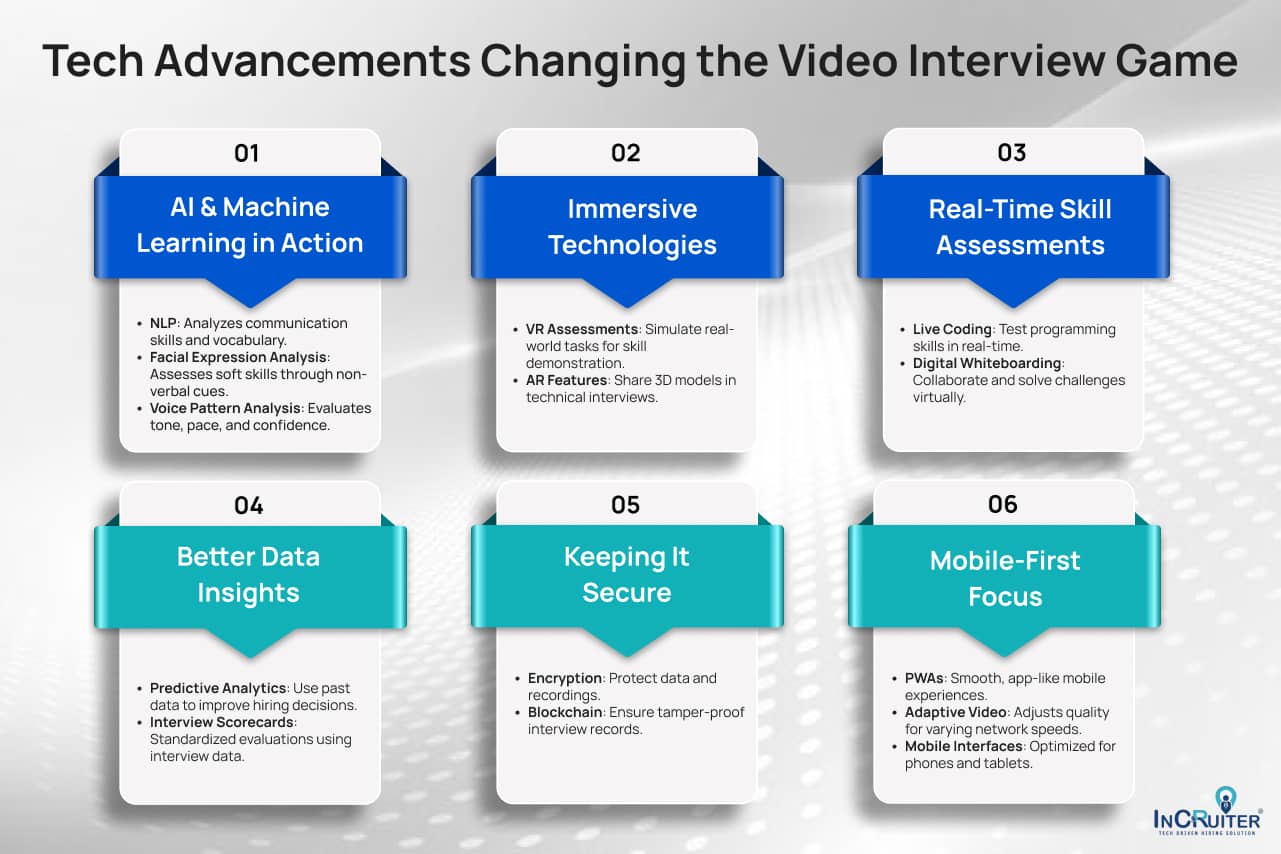Video interview tools have transitioned from being optional extras to must-have resources in modern recruitment. This shift is fueled by the demand for remote hiring, faster decision-making, and a seamless candidate experience. From global organizations embracing pre-recorded assessments for high-volume roles to tech firms leveraging live coding interviews, video interviewing tools are redefining how companies evaluate talent.
In this blog, we’ll dive into the historical adoption, current market trends, technological advancements, and future projections for video interviewing tools, backed by research, reports, and compelling statistics.
What is a Video interview tool?
Video interview tools, are digital platforms that facilitate live, real-time job interviews between interviewers and candidates remotely. These tools support seamless interactions, allowing interviewers to assess candidates effectively without the need for physical presence, making the hiring process more efficient and accessible.
The History Behind Video Interview Tools
Early Days (2000s)
The journey started in the early 2000s with video tools like Skype. These tools made it easier for big companies, especially tech firms, to connect with people from all over the world. But they weren’t perfect. Internet issues and the lack of features meant they were more of a backup than a main tool for hiring.
Growing and Evolving (2010s)
Fast forward to the 2010s, and things really started to change. With better internet and cloud tech, video interview platforms were born. These new tools were designed specifically for recruitment, making things smoother for everyone. Now, companies could use features like interview guides, video recordings for later review, and customizable questions. More businesses saw how much money and time they could save, and video interviews began to take off across industries.
Pandemic Push (2020)
Then came 2020 and the COVID-19 pandemic. Everything shifted. Remote work became a must, and video interviews went from a nice-to-have to a need-to-have. Recruitment platforms like InCruiter exploded in use. Suddenly, companies had to use video interviews to keep hiring, even with lockdowns. And with that, new features like AI evaluations, sentiment analysis, and automated assessments became highly in-demand, shaking up how recruitment worked.
Beyond (2020s)
Now, in the 2025s, video interview tools are a huge part of recruitment everywhere. These platforms have leveled up big time. Now, you can do coding tests (like Pair-programming), set up pre-recorded interviews for large-scale hiring, and even link everything to your Applicant Tracking System (ATS). All these features help companies hire smarter, faster, and more effectively, all while making the process smoother for candidates around the world.
Growing Market for Video Interview Tools
Video interviews are everywhere now, and it’s all because of remote work. It started a while ago, but now it’s exploding. In 2022, the market for video interview tools was worth $1.86 billion. By 2029? It’s expected to hit $3.48 billion. That’s a lot of growth!
Big companies are all over it. Google was one of the first to use video interviews for screening candidates. Amazon uses it too, especially when hiring lots of people at once. Microsoft and Facebook (Meta)? They use video interviews for tech jobs and remote positions.
But it’s not just tech companies. Other major businesses are jumping on board. Johnson & Johnson uses video interviews to keep their hiring process smooth across countries. Goldman Sachs holds tens of thousands of video interviews every year for new hires. Unilever cut their hiring time in half just by using video interviews, plus they saved a ton of money.
The numbers don’t lie. PwC’s survey found that 65% of companies use video interviews to screen candidates. LinkedIn’s report shows 81% of hiring pros believe video interviews are here to stay long-term. It’s no longer just an option. It’s a standard!
Key Drivers of Video Interview Tool Adoption
A bunch of global events and changes in the workplace have pushed video interview tools into the spotlight. Let’s take a closer look at why this shift happened.
COVID-19 Pushed the Change
The 2020 pandemic hit hard and fast, forcing companies to go digital in every way possible. With in-person interviews out of the question, video interviews became the only option. What started as a quick fix turned into something much bigger, as businesses realized how efficient and useful these tools were for hiring.
The Great Resignation’s Effect
Between 2021 and 2022, “The Great Resignation” hit hard. People were quitting jobs left and right, and companies were flooded with job applications. Video interview tools were a lifesaver in handling the overwhelming amount of candidates. They allowed recruiters to interview more people quickly without losing the quality of the hiring process.
Remote Work is Here to Stay
Remote work has completely changed how companies hire. Big names like Twitter, Shopify, and Airbnb made remote work permanent, and that’s when video interviews really made sense. It was a natural step in the shift to virtual offices and digital-first workplaces. Hiring and team-building could happen from anywhere.
Fighting for Global Talent
Hiring no longer has borders. Companies, like GitLab, have hired people from all over the world using video interviews, especially in tech, where there’s a shortage of local talent. This global approach is essential when local skills just aren’t enough to meet demands.
Saving the Planet
With more focus on the environment, video interviews help cut down on the need for travel. Companies like Google and Microsoft are using video interviews as part of their sustainability goals. Virtual interviews can save a huge amount of CO2 that would otherwise be spent on flights and travel.
The Need to Cut Costs
With all the economic ups and downs in recent years, companies are looking for ways to save money. Video interviews have helped lower costs by cutting out travel expenses, booking venues, and reducing admin work. IBM is one company that has saved big by shifting to virtual interviews.
The Digital Workforce
Generation Z is now entering the workforce, and they’re used to everything being digital. These digital natives expect tech-powered recruitment, making video interviews an obvious choice, especially for early career hiring programs.
Tech Advancements and AI
As video interview platforms advanced, so did the technology behind them. Now, companies can enjoy features like automated scheduling, sentiment analysis, and skill assessments. Unilever, for example, uses AI-driven video interviews to screen tons of candidates fast while keeping bias in check.
Resilience in Tough Times
When natural disasters or geopolitical issues hit, companies need a way to keep hiring without missing a beat. Video interview tools have shown to be crucial in these situations, allowing recruitment to continue without disruptions, no matter what’s going on in the world.
Tech Advancements Changing the Video Interview Game

Video interview tools are evolving fast, and technology is at the heart of this transformation. Let’s break down the latest innovations that are reshaping recruitment.
AI and Machine Learning in Action
Today’s video interview platforms are way more than just a way to see candidates. AI is now doing some heavy lifting:
- Natural Language Processing (NLP) helps companies understand how well candidates communicate, their vocabulary, and how clearly they speak. Companies like InCruiter use smart algorithms to analyze language skills in different languages.
- Facial Expression Analysis looks at candidates’ non-verbal cues, like their facial expressions and emotional reactions. This helps evaluate soft skills, but it’s done with care to avoid biases and respect privacy.
- Voice Pattern Analysis measures things like tone and pace, offering insights into how confident a candidate sounds and their communication style.
Immersive Technologies
Virtual Reality (VR) and Augmented Reality (AR) are stepping up the game:
- VR-Based Situational Assessments let candidates show off their skills in a simulated work environment. For example, tech candidates might solve problems in a virtual office, while sales candidates could handle fake customer calls.
- AR Features let interviewers share and manipulate 3D models during technical interviews. This is super useful for fields like engineering, architecture, and design.
Real-Time Skill Assessments
Now, candidates can show their skills right during the interview:
- Live Coding Assessments help tech candidates show off their programming skills as they’re being interviewed. Platforms like InCruiter Pair-programming interview have integrated this directly into video interviews.
- Digital Whiteboarding allows candidates to sketch and solve problems on a shared virtual board, making it easier to collaborate and solve real-time challenges.
Better Data Insights
Data processing has come a long way, giving recruiters more tools to evaluate candidates:
- Predictive Analytics helps companies understand what qualities make a successful hire by looking at past hiring data. This makes the interview process smarter.
- Interview Scorecards are automatically generated using data points collected during the interview, giving a standardized way to score and assess candidates.
Keeping It Secure
With sensitive data being shared, video interview platforms are stepping up their security:
- Encryption keeps interview recordings and candidate data safe from the start to the end of the process.
- Blockchain Technology is being explored to create tamper-proof interview records and verify candidate credentials.
Mobile-First Focus
Since most people use smartphones, platforms are improving mobile experiences:
- Progressive Web Apps (PWAs) provide smooth, app-like experiences on mobile without needing to download anything.
- Adaptive Video Quality adjusts the video to fit the network speed, keeping the interview looking professional even if the connection is spotty.
- Mobile-Friendly Interfaces ensure candidates and interviewers have a smooth experience on phones and tablets.
What’s Next for Video Interviews?
Looking ahead, there are even more exciting possibilities:
- 5G Networks will make video interviews smoother, with better quality and less lag, especially for global hiring.
- Quantum Computing might change how video platforms analyze huge amounts of data, making recruitment even faster and more accurate.
- Holographic Interviews are being tested, and they could bring a new level of immersion to interviews, creating an experience somewhere between virtual and in-person.
Global Adoption of Video Interview Tools: A Snapshot
Video interview tools are rapidly changing how companies hire across the world. By making the recruitment process faster and more efficient, these tools are gaining traction in many industries. Let’s break down how different regions are jumping on board and how things are expected to grow in the coming years.
North America
In 2023, North America leads the world in using video interviews, holding 42% of the global market. Tech companies are ahead, with 78% already using these tools. Other sectors, like finance (65%), healthcare (55%), and manufacturing (45%), are also embracing video interviews to speed up hiring.
By 2027, North America is expected to hold around 38-40% of the global share, with tech adoption growing even more to 85%. Other industries will continue to grow as well.
Europe
Europe holds 28% of the global market in 2023. The tech sector is again in the lead, with 65% using video interviews, followed by banking (60%) and retail (48%).
By 2027, Europe’s share is set to rise to 32%. The tech industry will still dominate, with 75% using video tools, while banking, retail, and manufacturing will see more growth.
Asia-Pacific
Asia-Pacific is growing quickly, holding 22% of the market in 2023. The tech industry leads here too, with 70% using video interviews. Other industries like e-commerce (65%) and healthcare (40%) are following suit.
By 2027, the region’s market share will increase to 25%, with tech companies leading at 82%. E-commerce, manufacturing, and healthcare will continue to grow their adoption.
Latin America
Latin America is still in the early stages of adopting video interviews, with only 5% of the global market share in 2023. The tech industry is leading the way, with 45% of companies using video tools, followed by financial services (38%) and retail (30%).
By 2027, Latin America is expected to grow to 7%, with tech companies growing to 60%. Financial services and retail will continue to adopt these tools.
Middle East and Africa
In the Middle East and Africa, video interviews are still taking off, holding just 3% of the global market share in 2023. The tech sector leads with 40% adoption, followed by banking (35%) and oil & gas (30%).
By 2027, the region’s market share is expected to grow to 5%. Tech companies will lead the way with 55%, while banking and oil & gas will also adopt more video interviews.
Challenges in Adopting Video Interviewing Software
Data Security and Privacy
Ensuring the protection of sensitive candidate information remains a top priority. Companies must adhere to global standards and regulations to maintain trust.
Technical Limitations
Internet connectivity and compatibility issues can create hurdles, particularly in regions with less developed digital infrastructure.
Bias in AI Tools
As AI becomes a central component of video interviewing platforms, ensuring its training data is accurate and unbiased is critical. If machine learning models are trained on flawed or imbalanced data, they risk producing incorrect or unfair suggestions during live candidate assessments. Such errors can undermine the credibility of the recruitment process, making it vital for organizations to monitor and improve their AI training datasets continuously.
Benefits for Employers and Recruiters
Better Hiring Decisions
Video interviews provide deeper insights into candidates’ abilities and interpersonal skills, enabling more informed hiring decisions.
Scalability
High-volume recruitment becomes manageable with tools designed to handle large candidate pools efficiently.
Collaboration
Video interviewing tools facilitate pair programming in technical interviews, now adopted by over 35% of companies for tech roles. This feature enables real-time collaboration on coding tasks, providing deeper insights into technical skills and teamwork capabilities.
Proctoring to Prevent Cheating
Advanced proctoring tools actively monitor candidate behavior during interviews, ensuring fairness and reducing the risk of dishonest practices.
Also read: Choosing the Right Video Interview Tool for Your Business
Conclusion
The rise of video interview tools has changed the way companies hire, offering a faster, more flexible, and accessible way to connect with candidates. These tools, which started as a simple alternative to in-person interviews, have now become essential in modern recruitment strategies. By speeding up the hiring process, reducing time-to-hire, and improving the overall candidate experience, video interviews have proven their value to organizations of all sizes.
As the demand for remote hiring continues to grow, video interview platforms will only become more critical in helping companies streamline their recruitment process. If you’re looking to enhance your hiring process, InCruiter’s Video interview solutions are the way to go.



















